Pageant sponsor letter template
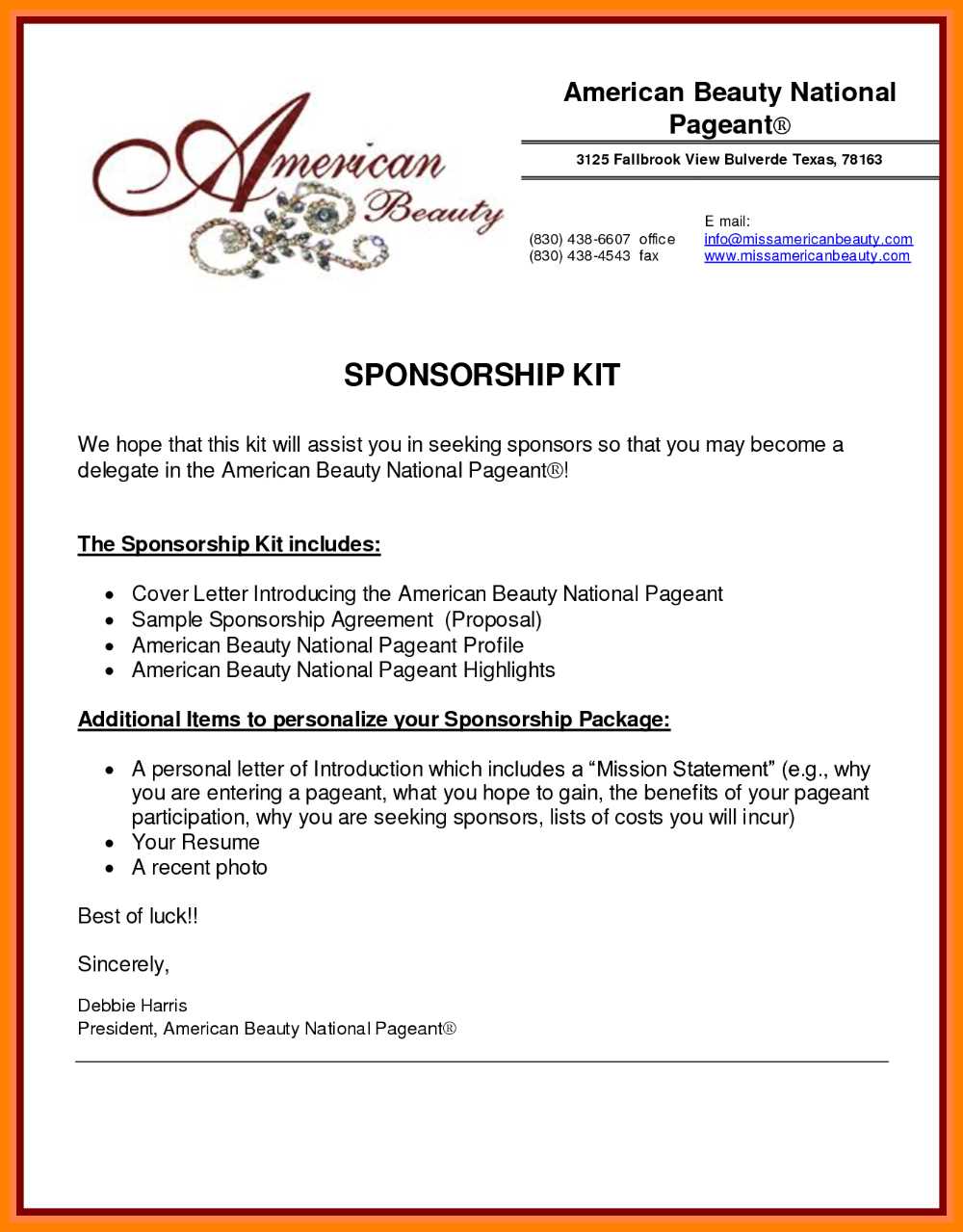
Writing a sponsor letter for a pageant is a straightforward process, but it requires a clear structure and focus on key details. Begin by addressing the sponsor directly, ensuring that their company or organization feels personally invited to participate. Make sure the tone is formal yet approachable, reflecting the pageant’s values and goals.
Next, highlight the specific benefits the sponsor will receive by participating, such as visibility, brand recognition, or community involvement. Be specific about the target audience and how the sponsor’s presence aligns with the event’s mission. You want the sponsor to see their support as a mutually beneficial partnership.
Lastly, express gratitude for their time and consideration, and make it easy for them to respond. Include clear contact details for further inquiries and emphasize the importance of their involvement in supporting the event’s success.
Pageant Sponsor Letter Template
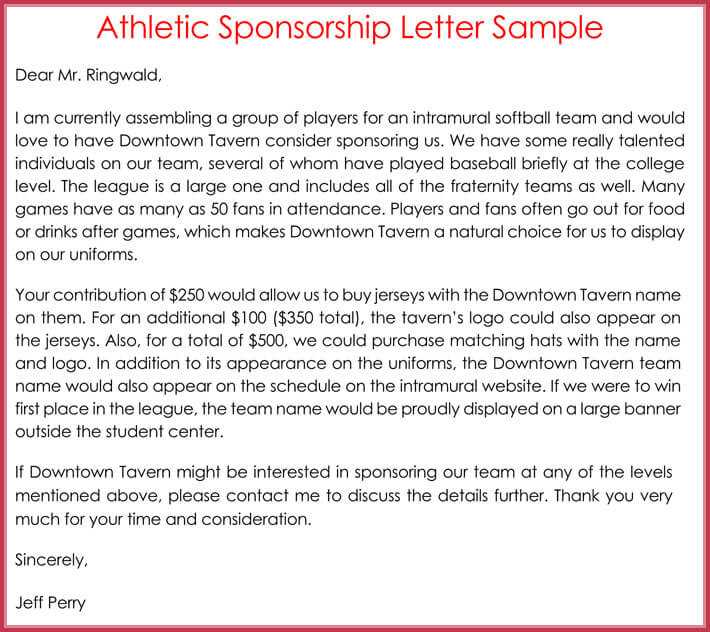
A well-crafted sponsor letter for a pageant should highlight the mutual benefits of the partnership. Below is a practical approach to creating an impactful letter.
1. Introduce the Event and Sponsorship Opportunity
Start by clearly stating the event you are hosting or involved in. Mention the specifics, such as the pageant’s location, date, and target audience. Then, introduce the sponsorship opportunities available, whether it’s through monetary donations, services, or products.
2. Outline the Benefits for the Sponsor
Make sure to communicate how the sponsor’s involvement can enhance their visibility. Include details about how the sponsor’s logo or products will be featured, such as on promotional materials, event signage, or during media coverage. Highlight the exposure to attendees and potential media attention.
| Benefit | Description |
|---|---|
| Event Promotion | Sponsor logos on banners, flyers, and digital media |
| Audience Engagement | Interactive opportunities like product booths or giveaways |
| Media Exposure | Recognition in press releases, social media, and TV coverage |
By offering these details, the letter shows potential sponsors how their investment will bring value beyond just financial support.
Identifying the Key Components of a Sponsor Letter
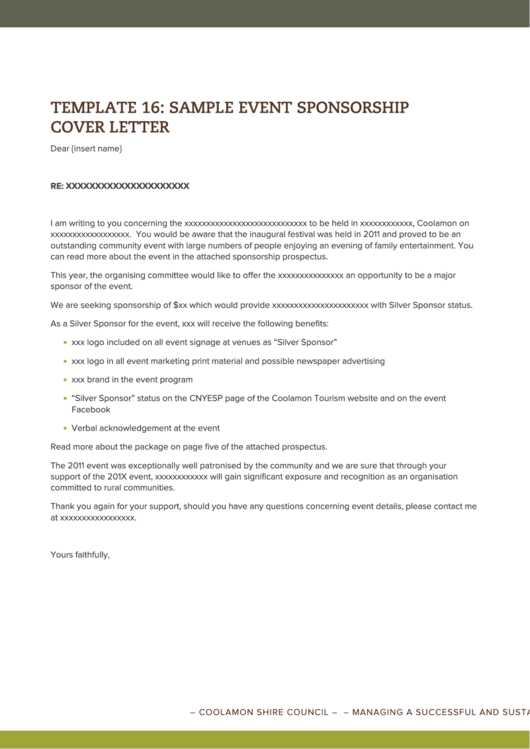
A well-structured sponsor letter contains several critical elements that ensure clarity and create a strong case for support. Focus on these components to craft a persuasive letter:
- Introduction: Open with a brief, direct introduction, stating the purpose of the letter and how the sponsor’s support is essential. Mention the event or initiative that requires sponsorship.
- Details of the Event or Initiative: Provide a concise overview of the event, including dates, location, expected attendance, and relevant activities. Highlight what makes it appealing to the sponsor’s target audience.
- Value Proposition: Explain the benefits the sponsor will gain. Outline how their brand will be exposed, the expected reach, and any other marketing opportunities associated with sponsorship.
- Sponsorship Packages: Offer clear options for sponsorship levels, detailing the benefits associated with each level. Include specifics about what the sponsor will receive in return for their contribution, such as logo placements, mentions, and special recognition.
- Call to Action: Encourage the sponsor to take the next step. Provide contact information and a clear invitation to discuss the details further. Make it easy for them to respond.
- Closing: Finish by expressing gratitude and reinforcing the potential impact of the sponsor’s involvement. Maintain a tone that is professional yet inviting.
Structuring the Offer
Make sure the offer feels tailored. Address specific goals and how sponsorship aligns with the sponsor’s objectives. Clear terms and concise information will foster trust and interest.
Professional Presentation
Formatting the letter professionally is as significant as the content. Ensure that it is visually appealing with proper alignment, margins, and a readable font. A well-formatted letter increases the chances of your sponsor letter being taken seriously.
Crafting a Compelling Opening for Your Letter
Begin by addressing the recipient by name, if possible. This immediately establishes a personal connection and shows that you value the reader’s time. A warm and direct approach works best to convey sincerity and respect. Mention the event or initiative you are supporting right away to set the context clearly. Express your enthusiasm for the opportunity to work together, as this will engage the reader and create a sense of excitement.
Be Clear and Concise
Avoid long-winded introductions. Get to the point quickly by stating why you are reaching out and how your support can benefit the event. This will ensure that your letter is not only readable but also focused on the objective. Ensure that your language is straightforward, allowing the recipient to understand your intent without unnecessary details.
Establish Your Credibility Early
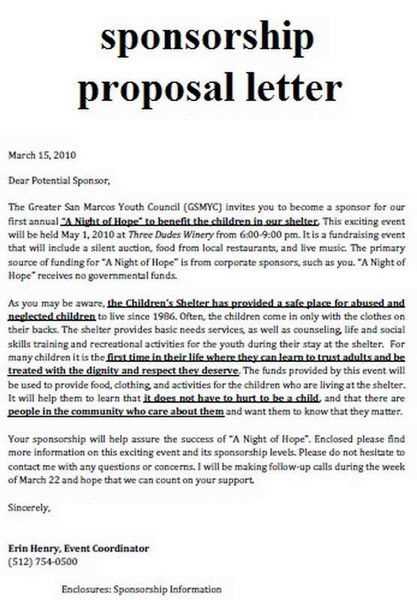
Briefly mention your experience or background that qualifies you to be involved in the event. Highlighting relevant expertise or previous contributions can build trust and reinforce your genuine interest in supporting the cause. This establishes a solid foundation for the rest of your letter.
Highlighting the Benefits for Sponsors
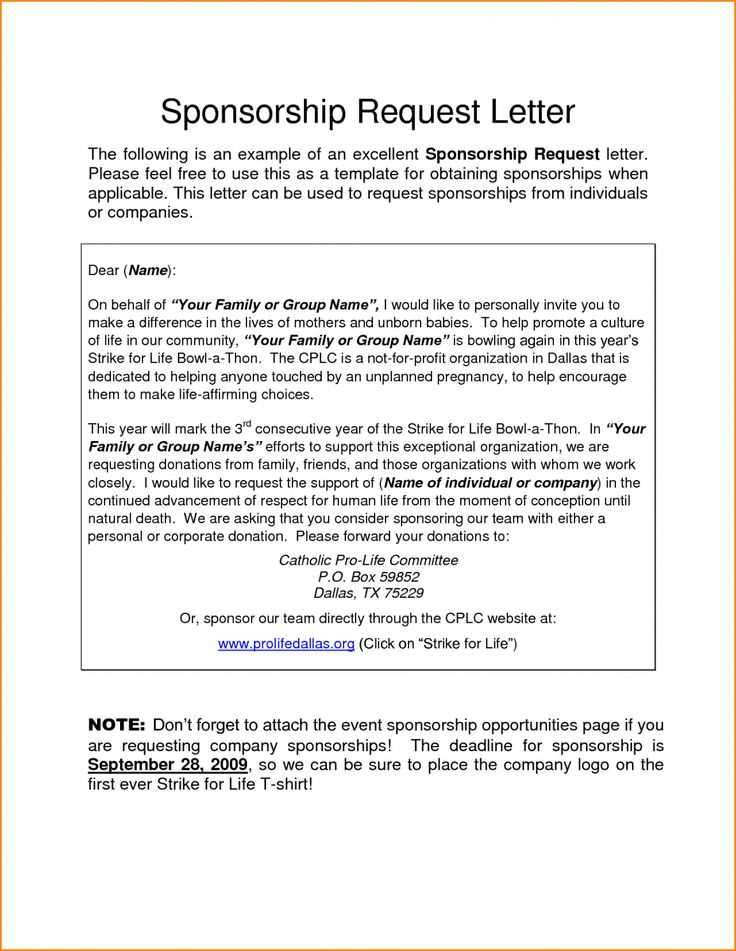
Sponsorship offers several direct advantages that strengthen brand visibility and engagement with target audiences. By sponsoring an event, a brand associates itself with a cause or event that resonates with potential customers, improving trust and loyalty. Here’s how sponsors benefit:
Increased Exposure and Brand Awareness
- Logo placement on event materials, websites, and promotional content amplifies recognition.
- Attendance at the event allows sponsors to interact with attendees, creating lasting impressions.
- Media coverage of the event extends the reach beyond the attendees to broader audiences.
Networking and Relationship Building
- Events bring together industry leaders and influencers, offering opportunities to network.
- Sponsors can build valuable connections with potential clients, partners, and collaborators.
- Exclusive access to VIP areas and private functions enhances relationship-building opportunities.
These elements make sponsorship a strategic investment that enhances visibility, trust, and future business opportunities.
Personalizing the Sponsorship Offer
Tailor the sponsorship offer to align with the specific goals and values of the potential sponsor. Begin by researching their past sponsorship activities and identify how your event aligns with their brand’s vision. Highlight the mutual benefits and emphasize the exposure they will receive. Show a clear understanding of their target audience and explain how your event will reach those individuals effectively.
Highlight Shared Values
Illustrate how your event supports causes that resonate with the sponsor’s mission. Make sure to reference their company’s core values or community involvement, demonstrating a shared vision. This connection adds authenticity to the partnership and creates a compelling reason for them to join.
Provide Customizable Options
Offer flexibility in the sponsorship levels, allowing sponsors to choose options that best fit their marketing goals. Customizing the sponsorship packages gives them a sense of control and ensures they get the most value for their investment. Include different benefits, such as logo placement, exclusive access, or engagement opportunities with attendees.
Conclude the offer with a clear call to action, encouraging them to reach out with questions or to discuss the next steps in more detail. A personalized approach increases the likelihood of a successful partnership, making it feel more like a collaboration than a transaction.
Providing Clear Sponsorship Tiers and Expectations
Clearly outline each sponsorship level with detailed benefits and responsibilities. Define the specific recognition, advertising opportunities, and involvement for each tier to ensure transparency. Specify whether sponsors receive logo placement, event mentions, or other promotional materials based on their contribution level.
Include the expectations tied to each tier. Specify timelines for payment, materials submission, or any involvement in event activities. Being precise helps sponsors understand what is required from them and when they can expect their commitments to be met.
Ensure you list the exact deliverables for both parties. Sponsors should know what to expect in return for their support, while you should highlight any obligations for the event’s success. This sets clear boundaries and reduces confusion.
Ending with a Strong Call to Action
Conclude your letter with a clear and direct request for action. Encourage the recipient to respond by specifying what steps they should take next, whether it’s setting up a meeting or confirming sponsorship. Make it easy for them to act by providing relevant contact details or next steps.
Make It Easy to Respond
Give clear instructions on how they can get involved or commit. Include contact information, deadlines, or any forms they need to fill out. This reduces friction and increases the likelihood of a positive response.
Express Enthusiasm
Show your excitement about the potential partnership. Let them know how their support will make a significant impact. A positive tone can motivate the sponsor to take immediate action.